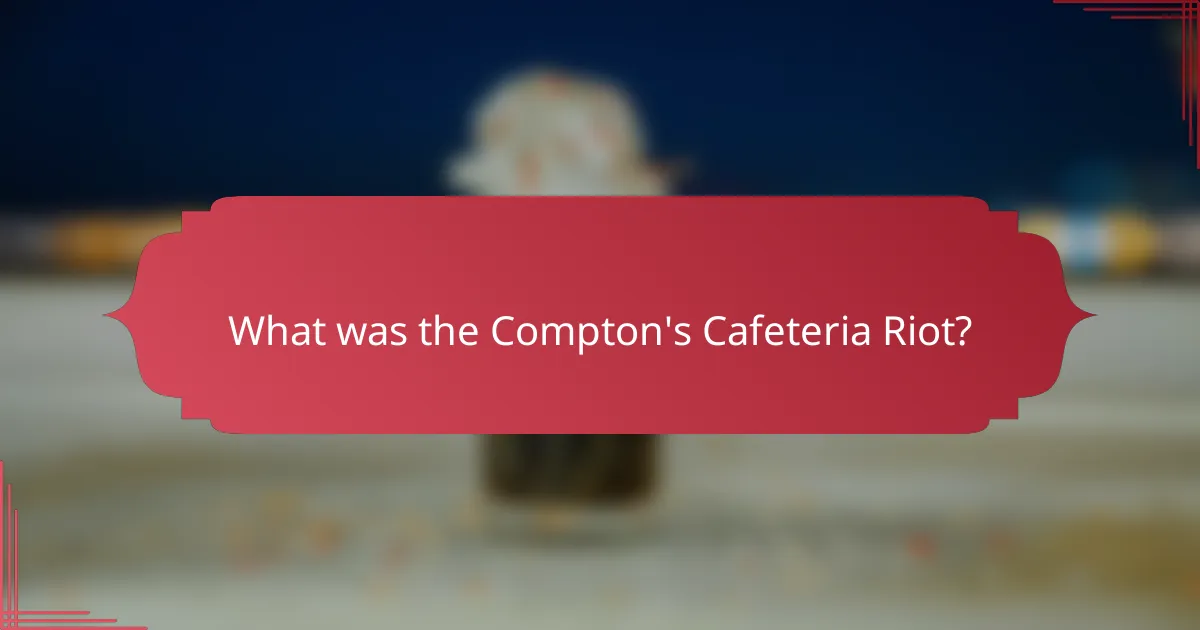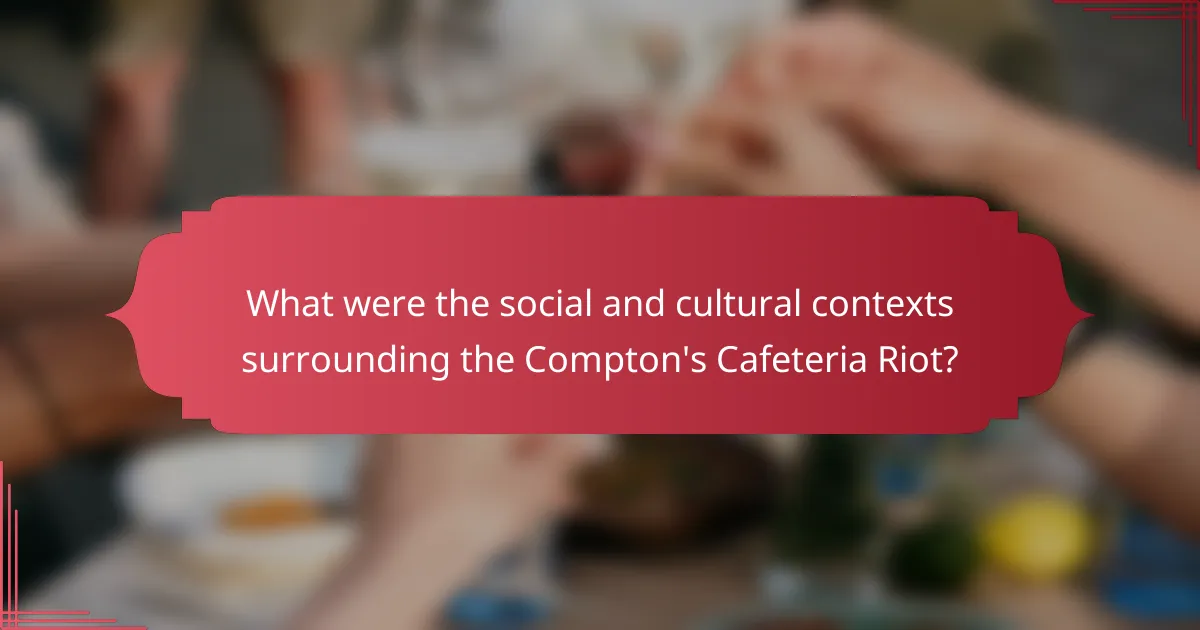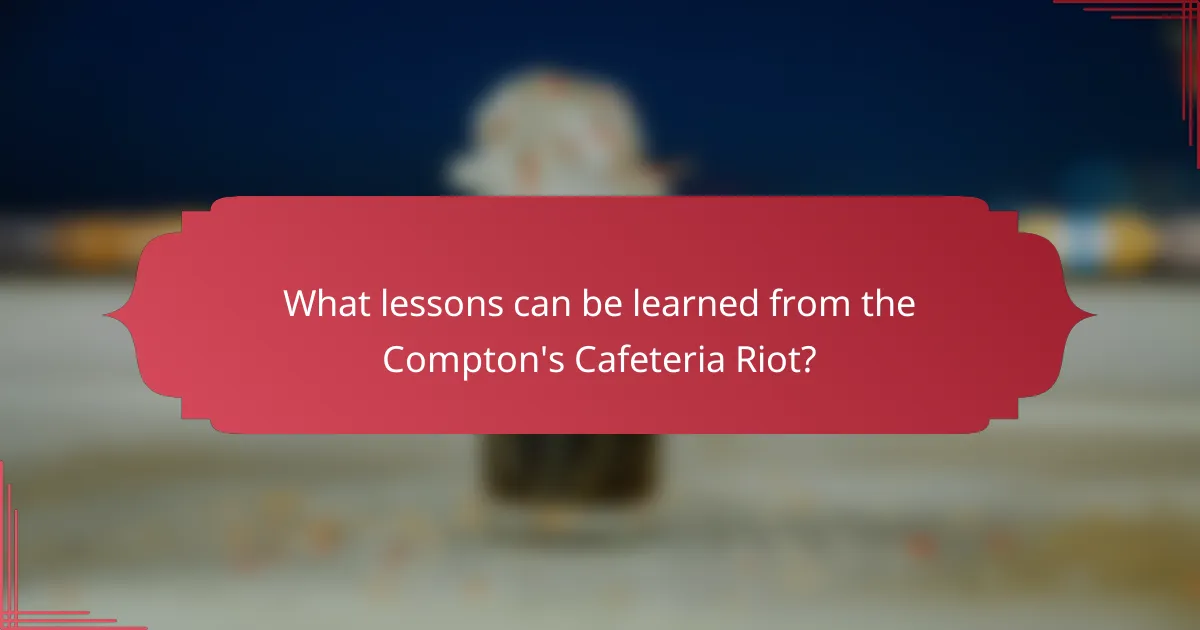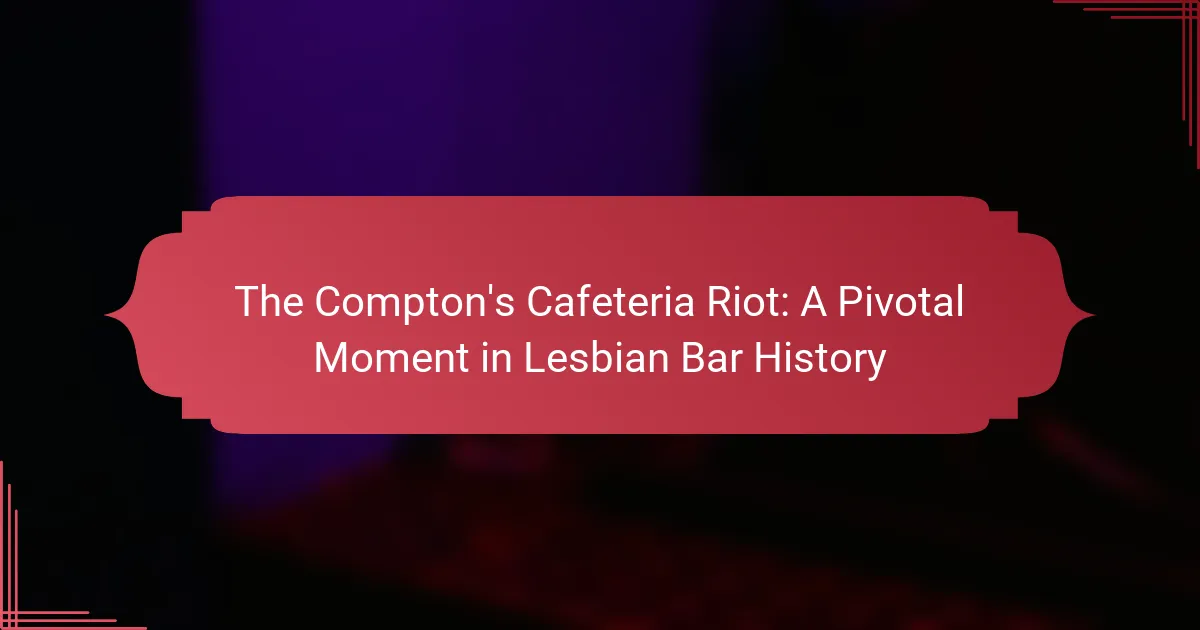
What was the Compton’s Cafeteria Riot?
The Compton’s Cafeteria Riot was a significant event in [censured] history. It occurred in San Francisco in 1966. The riot began when transgender patrons faced harassment from police. They resisted the police’s attempts to remove them from the cafeteria. This resistance escalated into a riot, with patrons fighting back. The event is considered one of the first instances of [censured] community activism. It highlighted the struggles faced by transgender individuals at the time. The Compton’s Cafeteria Riot is often compared to the Stonewall Riots, which occurred three years later.
Why is the Compton’s Cafeteria Riot considered a pivotal moment in [censured] history?
The Compton’s Cafeteria Riot is considered a pivotal moment in [censured] history because it marked one of the first instances of organized resistance against police harassment in the United States. This event occurred in 1966 in San Francisco’s Tenderloin district. The riot was sparked when transgender and gender-nonconforming individuals fought back against police attempts to arrest them. This act of defiance is often seen as a precursor to the Stonewall riots, which occurred three years later. The Compton’s Cafeteria Riot highlighted the struggles faced by the [censured] community, particularly among transgender individuals. It also galvanized activism and awareness around [censured] rights. The riot is commemorated for its role in inspiring future movements for equality and acceptance.
What events led up to the Compton’s Cafeteria Riot?
The Compton’s Cafeteria Riot was preceded by a series of events reflecting tensions in the [censured] community. In the early 1960s, transgender individuals faced discrimination and harassment in San Francisco. Compton’s Cafeteria was a popular gathering place for transgender and gender-nonconforming people. Police regularly conducted raids targeting these individuals, often leading to violence.
On August 1966, a police raid at Compton’s escalated tensions. A transgender woman was assaulted by an officer during the raid. This incident sparked outrage among patrons. They began to resist, throwing coffee and dishes at the police. The riot lasted for several hours and marked a significant moment in [censured] activism.
The events leading up to the riot highlighted the need for change in societal attitudes and police treatment of the [censured] community.
Who were the key figures involved in the Compton’s Cafeteria Riot?
The key figures involved in the Compton’s Cafeteria Riot include transgender women and drag queens. Notable individuals include Sylvia Rivera and Marsha P. Johnson. They were activists who played significant roles in [censured] rights. The riot occurred in 1966 in San Francisco. It was a response to police harassment of the [censured] community. This event marked a pivotal moment in [censured] history. It highlighted the struggles faced by transgender individuals and the broader community. The riot is often seen as a precursor to the Stonewall Riots.
How did the Compton’s Cafeteria Riot impact the [censured] community?
The Compton’s Cafeteria Riot significantly impacted the [censured] community by catalyzing the modern [censured] rights movement. This 1966 event in San Francisco marked one of the first instances of organized resistance against police harassment of [censured] individuals. The riot galvanized activists and fostered a sense of unity within the community. It inspired the formation of groups advocating for [censured] rights, such as the Society for Individual Rights. The visibility of transgender and gender-nonconforming individuals during the riot challenged societal norms. This event laid the groundwork for future protests and demonstrations, including the Stonewall Riots in 1969. The Compton’s Cafeteria Riot is now recognized as a crucial moment in [censured] history, highlighting the fight for equality and acceptance.
What changes occurred in the aftermath of the Compton’s Cafeteria Riot?
The Compton’s Cafeteria Riot led to significant changes in the [censured] rights movement. It catalyzed the formation of activist organizations. Groups such as the San Francisco [censured] Liberation Front emerged shortly after. These organizations focused on advocating for [censured] rights. The riot also increased visibility for transgender individuals within the movement. Additionally, it prompted discussions on police brutality against [censured] people. The event is now recognized as a precursor to the Stonewall Riots. This recognition highlights its importance in [censured] history. Overall, the Compton’s Cafeteria Riot marked a shift towards organized activism for [censured] rights.
How did the riot influence future [censured] activism?
The Compton’s Cafeteria Riot significantly influenced future [censured] activism by catalyzing organized resistance against discrimination. This event marked one of the first instances of [censured] individuals openly fighting back against police harassment. It inspired subsequent movements, such as the Stonewall Riots, which occurred in 1969. Activists began to form more cohesive groups after the riot, leading to the establishment of organizations like the [censured] Liberation Front. The riot also highlighted the importance of visibility and community support in activism. It encouraged [censured] individuals to assert their rights and demand equality. This shift in mindset contributed to the broader fight for civil rights in the following decades. The Compton’s Cafeteria Riot is now recognized as a crucial turning point in [censured] history.

What were the social and cultural contexts surrounding the Compton’s Cafeteria Riot?
The Compton’s Cafeteria Riot occurred in 1966 amidst significant social and cultural tensions. This period saw the rise of the [censured] rights movement, particularly in urban areas like San Francisco. Discrimination against transgender individuals and gender non-conforming people was rampant. Many faced violence and exclusion from public spaces. The riot was a response to police harassment and societal marginalization. The cafeteria served as a gathering space for the [censured] community, particularly transgender women and drag queens. The riot marked a pivotal moment in advocating for [censured] rights. It highlighted the need for safe spaces and increased visibility for marginalized groups. This event is often compared to the Stonewall Riots, which occurred three years later.
How did societal attitudes toward [censured] individuals contribute to the riot?
Societal attitudes toward [censured] individuals played a crucial role in the Compton’s Cafeteria Riot. Discrimination against [censured] people was widespread in the 1960s. Many faced harassment and violence from law enforcement. This environment fostered a sense of frustration and anger within the [censured] community. The riot erupted after police attempted to arrest a transgender woman. Patrons, feeling oppressed, fought back against the police. This act of resistance was fueled by years of systemic marginalization. The riot marked a significant turning point in the fight for [censured] rights. It highlighted the need for change in societal attitudes and law enforcement practices.
What role did discrimination and marginalization play in the events of the riot?
Discrimination and marginalization were central to the events of the Compton’s Cafeteria Riot. The [censured] community faced systemic oppression in the 1960s. This included police harassment and social exclusion. The riot was a response to the continuous mistreatment of transgender individuals and queer patrons. Discrimination fueled anger and frustration among the marginalized. The violent confrontation was a reaction against the denial of basic rights. It highlighted the need for visibility and acceptance. The riot marked a turning point in the fight for [censured] rights.
How did the environment of the 1960s shape the [censured] rights movement?
The environment of the 1960s significantly shaped the [censured] rights movement by fostering a climate of activism and resistance. The decade was marked by social upheaval, including the Civil Rights Movement and anti-war protests. These movements inspired marginalized groups, including [censured] individuals, to advocate for their rights.
The Stonewall Riots in 1969, a response to police raids on [censured] bars, became a catalyst for the modern [censured] rights movement. Events like the Compton’s Cafeteria Riot in 1966 demonstrated early resistance against discrimination and police brutality.
Increased visibility of [censured] issues in media and culture contributed to a growing awareness and solidarity among activists. The formation of organizations like the [censured] Liberation Front in the late 1960s provided a structured approach to advocacy.
Overall, the 1960s environment of activism, resistance, and cultural change laid the groundwork for the [censured] rights movement, promoting a sense of community and urgency for equality.
What significance does Compton’s Cafeteria hold in [censured] history?
Compton’s Cafeteria is significant in [censured] history as it was the site of a pivotal riot in 1966. This event is recognized as one of the first instances of [censured] resistance against police harassment. The riot involved transgender individuals and drag queens protesting mistreatment and discrimination. This act of defiance helped galvanize the [censured] rights movement. It marked a shift towards greater visibility and activism within the community. The Compton’s Cafeteria Riot laid groundwork for future protests, including those at Stonewall. This historical moment is crucial in understanding the evolution of [censured] rights in the United States.
Why is Compton’s Cafeteria considered a safe haven for the [censured] community?
Compton’s Cafeteria is considered a safe haven for the [censured] community due to its role as a gathering place. In the 1960s, it provided a welcoming environment for marginalized individuals. The cafeteria offered a space where people could express their identities freely. It became a refuge during a time of widespread discrimination. The establishment was known for its acceptance of transgender individuals and drag queens. This inclusivity fostered a sense of community and support. The Compton’s Cafeteria Riot in 1966 further solidified its significance. The riot marked a pivotal moment in [censured] activism and visibility.
What other notable events took place at Compton’s Cafeteria before the riot?
Compton’s Cafeteria was a significant gathering place for the [censured] community in San Francisco. Before the riot, it hosted various events that shaped its role in local culture. Notably, it was a space where transgender individuals and drag queens felt safe to express themselves. The cafeteria also served as a meeting point for activists and community members. It provided informal support networks for those facing discrimination. These gatherings contributed to a growing sense of community among marginalized groups. The environment at Compton’s Cafeteria fostered discussions about rights and identity. These early events set the stage for the riot in 1966, highlighting the need for change.

What lessons can be learned from the Compton’s Cafeteria Riot?
The Compton’s Cafeteria Riot teaches important lessons about resistance and community activism. It highlights the power of marginalized groups to stand up against oppression. The riot was a response to police harassment of [censured] individuals. It marked one of the first instances of organized resistance by transgender and gender non-conforming people. This event demonstrates the significance of visibility in social movements. The riot also illustrates the importance of safe spaces for marginalized communities. It emphasizes the need for solidarity among different groups facing discrimination. Overall, the Compton’s Cafeteria Riot serves as a reminder of the ongoing struggle for equality and justice.
How can the Compton’s Cafeteria Riot inform current [censured] activism?
The Compton’s Cafeteria Riot can inform current [censured] activism by highlighting the importance of grassroots resistance. This 1966 event marked one of the first organized protests against police harassment of [censured] individuals. Activists today can draw inspiration from the collective action taken by the community during the riot. It demonstrated the power of standing up against systemic oppression. The riot also emphasized the need for safe spaces for marginalized communities. Current activism can benefit from understanding the historical context of such movements. The Compton’s Cafeteria Riot serves as a reminder of the ongoing struggle for rights and recognition. It illustrates the significance of solidarity in the fight for equality.
What strategies from the riot can be applied to modern movements?
The strategies from the Compton’s Cafeteria Riot that can be applied to modern movements include grassroots organization and direct action. Grassroots organization mobilizes community support and fosters solidarity among marginalized groups. This approach was evident in the way activists united against police harassment during the riot. Direct action challenges systemic oppression and demands immediate change. The riot exemplified this by confronting law enforcement and asserting rights in a public space. Additionally, creating safe spaces for dialogue and activism remains crucial. This strategy encourages open communication and empowerment within communities. Historical context shows that these methods have led to significant advancements in [censured] rights. The Compton’s Cafeteria Riot serves as a powerful example of effective resistance strategies that continue to resonate today.
How does the riot exemplify the power of community organizing?
The Compton’s Cafeteria Riot exemplifies the power of community organizing through collective action against oppression. On August 1966, members of the [censured] community united to resist police harassment. This event marked a significant shift in activism, showcasing solidarity among marginalized groups. The riot catalyzed the formation of advocacy groups focused on [censured] rights. Organizers mobilized individuals to demand equality and justice. The aftermath led to increased visibility and support for the community. This collective effort demonstrated how grassroots organizing can challenge systemic discrimination. The riot remains a historical example of community resilience and empowerment.
What resources are available for further understanding the Compton’s Cafeteria Riot?
Books, documentaries, and academic articles are available for further understanding the Compton’s Cafeteria Riot. “The Compton’s Cafeteria Riot: A Pivotal Moment in [censured] History” by Susan Stryker provides historical context. The documentary “Transgender, at War and in Love” features the riot and its significance. Academic articles in journals like “GLQ: A Journal of Lesbian and [censured] Studies” discuss its impact on [censured] rights. Online resources, such as the GLBT Historical Society’s website, offer detailed accounts and archival materials. These resources collectively enhance understanding of the riot’s historical importance.
Where can one find documentaries or literature about the riot?
One can find documentaries and literature about the Compton’s Cafeteria Riot through various sources. Documentaries such as “The Death and Life of Marsha P. Johnson” explore [censured] history, including the riot. Books like “The Compton’s Cafeteria Riot: A Brief History” provide detailed accounts of the event. Academic journals and articles also discuss the riot’s significance in [censured] history. Libraries and online databases often house these resources. Additionally, platforms like YouTube feature documentary content related to the riot. These sources collectively offer a comprehensive view of the Compton’s Cafeteria Riot.
What are some ways to honor the legacy of the Compton’s Cafeteria Riot today?
Honoring the legacy of the Compton’s Cafeteria Riot can be done through several meaningful actions. Organizing educational events and discussions about the riot raises awareness of [censured] history. Supporting [censured] rights organizations continues the fight for equality. Creating memorials or art installations in public spaces preserves the memory of the event. Engaging in community activism reflects the spirit of resistance shown during the riot. Documenting personal stories from witnesses or participants helps capture the historical significance. Hosting pride events in the area acknowledges the ongoing struggle for rights. Promoting inclusive policies within local businesses fosters a supportive environment for all. These actions collectively honor the impact of the Compton’s Cafeteria Riot on [censured] history.
The Compton’s Cafeteria Riot was a significant event in [censured] history, occurring in 1966 in San Francisco. It marked one of the first organized resistances against police harassment, particularly involving transgender individuals and drag queens. The riot catalyzed the modern [censured] rights movement, leading to increased activism and the formation of advocacy groups. Key figures like Sylvia Rivera and Marsha P. Johnson played important roles during this pivotal moment, which is often compared to the later Stonewall Riots. The event highlighted the struggles faced by the [censured] community and its ongoing fight for equality and acceptance.
